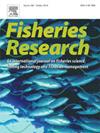Characterization of European sprat acoustic backscatter through modeling techniques: A comparison with in situ observations in the Mediterranean Sea
IF 2.2
2区 农林科学
Q2 FISHERIES
引用次数: 0
Abstract
In fisheries acoustics, the identification of targets and the precise conversion of acoustic energy into biologically important meaningful metrics remain a challenge. Backscattering cross-section, or its logarithmic form, Target Strength (TS, dB re 1 m2), is a key parameter in this process. While numerous studies exist on the TS of commercially important species, there is a paucity of research on commercially ancillary species, such as the European sprat in the Mediterranean Sea, which is nonetheless of great importance for the pelagic ecosystem. The application of backscattering models can enhance our understanding of this species’ acoustic properties. In this study, we applied several backscattering models on three-dimensional swim bladder shapes derived from Computer Tomography (CT) scans of sprat collected during the MEDiterranean International Acoustic Survey (MEDIAS). The theoretical TS pattern was compared with empirical empirically TS measurements, demonstrating a good fit at 38 and 70 kHz between 0° (broadside incidence) and −20°. Significant differences were observed at higher frequencies and tilt angles. This study provides estimates of the relative frequency response and broadband backscatter of sprat in the Mediterranean Sea. We proposed a new relevant TS to length relationship of 20 log(L)-68.3 dB re 1 m2 at 38 kHz for European sprat in the Mediterranean Sea.
通过模拟技术表征欧洲鲱鱼声学后向散射:与地中海现场观测的比较
在渔业声学中,目标的识别和将声能精确转换为生物学上重要的有意义的指标仍然是一个挑战。后向散射截面,或其对数形式,目标强度(TS, dB re 1 m2)是此过程中的关键参数。虽然对重要商业物种的TS进行了大量研究,但对商业辅助物种的研究却很少,例如地中海的欧洲鲽鱼,它对远洋生态系统非常重要。后向散射模型的应用可以提高我们对该物种声学特性的认识。在这项研究中,我们对地中海国际声学调查(MEDIAS)期间收集的鲱鱼的计算机断层扫描(CT)得出的三维鱼鳔形状应用了几种后向散射模型。将理论TS模式与经验TS测量结果进行了比较,证明在0°(舷侧入射)和- 20°之间的38和70 kHz处具有良好的拟合性。在较高频率和倾斜角度下观察到显著差异。本研究提供了地中海小鱼的相对频率响应和宽带后向散射的估计。我们提出了一个新的相关TS -长度关系为20 log(L)-68.3 dB re 1 m2在38 kHz在地中海的欧洲sprat。
本文章由计算机程序翻译,如有差异,请以英文原文为准。
求助全文
约1分钟内获得全文
求助全文
来源期刊

Fisheries Research
农林科学-渔业
CiteScore
4.50
自引率
16.70%
发文量
294
审稿时长
15 weeks
期刊介绍:
This journal provides an international forum for the publication of papers in the areas of fisheries science, fishing technology, fisheries management and relevant socio-economics. The scope covers fisheries in salt, brackish and freshwater systems, and all aspects of associated ecology, environmental aspects of fisheries, and economics. Both theoretical and practical papers are acceptable, including laboratory and field experimental studies relevant to fisheries. Papers on the conservation of exploitable living resources are welcome. Review and Viewpoint articles are also published. As the specified areas inevitably impinge on and interrelate with each other, the approach of the journal is multidisciplinary, and authors are encouraged to emphasise the relevance of their own work to that of other disciplines. The journal is intended for fisheries scientists, biological oceanographers, gear technologists, economists, managers, administrators, policy makers and legislators.
 求助内容:
求助内容: 应助结果提醒方式:
应助结果提醒方式:


